Standoff Infrared Measurements of Chemical Plume Dynamics in Complex Terrain Using a Combination of Active Swept-ECQCL Laser Spectroscopy with Passive Hyperspectral Imaging
Abstract
:1. Introduction
2. Materials and Methods
2.1. Site Description
2.2. Spatial-Temporal Plume Characterization Using Hyperspectral Imaging
2.3. High-Speed Plume Detection Using Standoff Swept-ECQCL System
3. Results
Plume Detection with Hyperspectral Imager and Standoff Swept-ECQCL Systems
4. Discussion
Characterization of Performance for Swept-ECQCL and Hyperspectral Imaging Systems
5. Conclusions
Supplementary Materials
Author Contributions
Funding
Data Availability Statement
Acknowledgments
Conflicts of Interest
Appendix A. High-Speed Plume Characterization Using Swept-ECQCL Instrument
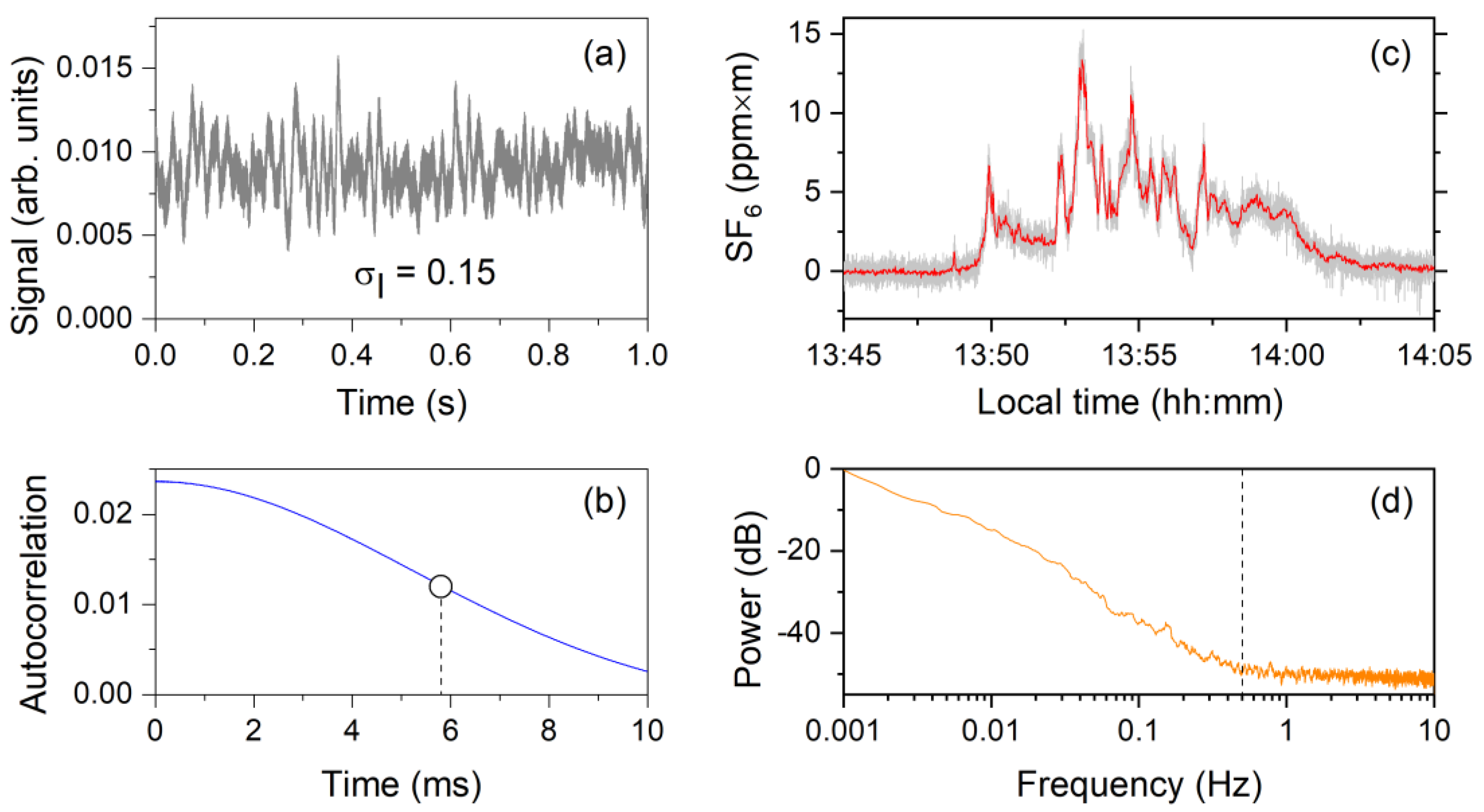
References
- Steyn, D.; De Wekker, S.; Kossmann, M.; Martilli, A. Boundary Layers and Air Quality in Mountainous Terrain. In Mountain Weather Research and Forecasting; Chow, F., De Wekker, S., Snyder, B., Eds.; Springer: Dordrecht, The Netherlands, 2013; pp. 261–289. ISBN 978-94-007-4097-6. [Google Scholar]
- Giovannini, L.; Ferrero, E.; Karl, T.; Rotach, M.W.; Staquet, C.; Trini Castelli, S.; Zardi, D. Atmospheric Pollutant Dispersion over Complex Terrain: Challenges and Needs for Improving Air Quality Measurements and Modeling. Atmosphere 2020, 11, 646. [Google Scholar] [CrossRef]
- Fernando, H.J.S.; Pardyjak, E.R.; Di Sabatino, S.; Chow, F.K.; De Wekker, S.F.J.; Hoch, S.W.; Hacker, J.; Pace, J.C.; Pratt, T.; Pu, Z.; et al. The Materhorn: Unraveling the Intricacies of Mountain Weather. Bull. Am. Meteorol. Soc. 2015, 96, 1945–1967. [Google Scholar] [CrossRef]
- Whiteman, C.D. Mountain Meteorology: Fundamentals and Applications; Oxford University Press: New York, NY, USA, 2000; ISBN 978-0-19-513271-7. [Google Scholar]
- Zardi, D.; Rotach, M.W. Transport and Exchange Processes in the Atmosphere over Mountainous Terrain: Perspectives and Challenges for Observational and Modelling Systems, from Local to Climate Scales. Atmosphere 2021, 12, 199. [Google Scholar] [CrossRef]
- Sekiyama, T.T.; Kajino, M. Reproducibility of Surface Wind and Tracer Transport Simulations over Complex Terrain Using 5-, 3-, and 1-Km-Grid Models. J. Appl. Meteorol. Climatol. 2020, 59, 937–952. [Google Scholar] [CrossRef] [Green Version]
- Costigan, K.R. Tracking Virtual, Atmospheric Emissions from Time-Varying and Short-Term Sources During the DNE18 Study Time Period. In Proceedings of the AGU Fall Meeting, Washington, DC, USA, 1 December 2018. [Google Scholar]
- Wagenbrenner, N.S.; Forthofer, J.M.; Lamb, B.K.; Shannon, K.S.; Butler, B.W. Downscaling Surface Wind Predictions from Numerical Weather Prediction Models in Complex Terrain with Windninja. Atmos. Chem. Phys. 2016, 16, 5229–5241. [Google Scholar] [CrossRef] [Green Version]
- Phillips, M.C.; Taubman, M.S.; Bernacki, B.E.; Cannon, B.D.; Stahl, R.D.; Schiffern, J.T.; Myers, T.L. Real-Time Trace Gas Sensing of Fluorocarbons Using a Swept-Wavelength External Cavity Quantum Cascade Laser. Analyst 2014, 139, 2047–2056. [Google Scholar] [CrossRef]
- You, Y.; Staebler, R.M.; Moussa, S.G.; Su, Y.; Munoz, T.; Stroud, C.; Zhang, J.; Moran, M.D. Long-Path Measurements of Pollutants and Micrometeorology over Highway 401 in Toronto. Atmos. Chem. Phys. 2017, 17, 14119–14143. [Google Scholar] [CrossRef] [Green Version]
- Griffith, D.W.T.; Pohler, D.; Schmitt, S.; Hammer, S.; Vardag, S.N.; Platt, U. Long Open-Path Measurements of Greenhouse Gases in Air Using near-Infrared Fourier Transform Spectroscopy. Atmos. Meas. Tech. 2018, 11, 1549–1563. [Google Scholar] [CrossRef] [Green Version]
- Akagi, S.K.; Burling, I.R.; Mendoza, A.; Johnson, T.J.; Cameron, M.; Griffith, D.W.T.; Paton-Walsh, C.; Weise, D.R.; Reardon, J.; Yokelson, R.J. Field Measurements of Trace Gases Emitted by Prescribed Fires in Southeastern US Pine Forests Using an Open-Path FTIR System. Atmos. Chem. Phys. 2014, 14, 199–215. [Google Scholar] [CrossRef] [Green Version]
- Yokelson, R.J.; Griffith, D.W.T.; Ward, D.E. Open-Path Fourier Transform Infrared Studies of Large-Scale Laboratory Biomass Fires. J. Geophys. Res. Atmos. 1996, 101, 21067–21080. [Google Scholar] [CrossRef] [Green Version]
- Li, J.; Yu, Z.; Du, Z.; Ji, Y.; Liu, C. Standoff Chemical Detection Using Laser Absorption Spectroscopy: A Review. Remote Sens. 2020, 12, 2771. [Google Scholar] [CrossRef]
- Macleod, N.A.; Molero, F.; Weidmann, D. Broadband Standoff Detection of Large Molecules by Mid-Infrared Active Coherent Laser Spectrometry. Opt. Express 2015, 23, 912–928. [Google Scholar] [CrossRef]
- Macleod, N.A.; Rose, R.; Weidmann, D. Middle Infrared Active Coherent Laser Spectrometer for Standoff Detection of Chemicals. Opt. Lett. 2013, 38, 3708–3711. [Google Scholar] [CrossRef] [PubMed]
- Goyal, A.K.; Kotidis, P.; Deutsch, E.R.; Zhu, N.; Norman, M.; Ye, J.; Zafiriou, K.; Mazurenko, A. Detection of Chemical Clouds Using Widely Tunable Quantum Cascade Lasers. Proc. SPIE 2015, 9455, 94550L. [Google Scholar] [CrossRef]
- Phillips, M.C.; Bernacki, B.E.; Harilal, S.S.; Yeak, J.; Jones, R.J. Standoff Chemical Plume Detection in Turbulent Atmospheric Conditions with a Swept-Wavelength External Cavity Quantum Cascade Laser. Opt. Express 2020, 28, 7408–7424. [Google Scholar] [CrossRef] [PubMed]
- Rieker, G.B.; Giorgetta, F.R.; Swann, W.C.; Kofler, J.; Zolot, A.M.; Sinclair, L.C.; Baumann, E.; Cromer, C.; Petron, G.; Sweeney, C.; et al. Frequency-Comb-Based Remote Sensing of Greenhouse Gases over Kilometer Air Paths. Optica 2014, 1, 290–298. [Google Scholar] [CrossRef] [Green Version]
- Nikodem, M.; Wysocki, G. Chirped Laser Dispersion Spectroscopy for Remote Open-Path Trace-Gas Sensing. Sensors 2012, 12, 16466–16481. [Google Scholar] [CrossRef]
- Kara, O.; Sweeney, F.; Rutkauskas, M.; Farrell, C.; Leburn, C.G.; Reid, D.T. Open-Path Multi-Species Remote Sensing with a Broadband Optical Parametric Oscillator. Opt. Express 2019, 27, 21358–21366. [Google Scholar] [CrossRef] [PubMed]
- Winker, D.M.; Hunt, W.H.; McGill, M.J. Initial Performance Assessment of Caliop. Geophys. Res. Lett. 2007, 34. [Google Scholar] [CrossRef] [Green Version]
- Kariminezhad, H.; Parvin, P.; Borna, F.; Bavali, A. SF6 Leak Detection of High-Voltage Installations Using TEA-CO2 Laser-Based DIAL. Opt. Lasers Eng. 2010, 48, 491–499. [Google Scholar] [CrossRef]
- Uthe, E.E. Airborne CO2 Dial Measurement of Atmospheric Tracer Gas Concentration Distributions. Appl. Opt. 1986, 25, 2492–2498. [Google Scholar] [CrossRef] [PubMed]
- Pappalardo, G.; Amodeo, A.; Apituley, A.; Comeron, A.; Freudenthaler, V.; Linné, H.; Ansmann, A.; Bösenberg, J.; D’Amico, G.; Mattis, I.; et al. Earlinet: Towards an Advanced Sustainable European Aerosol Lidar Network. Atmos. Meas. Tech. 2014, 7, 2389–2409. [Google Scholar] [CrossRef] [Green Version]
- Ghandehari, M.; Aghamohamadnia, M.; Dobler, G.; Karpf, A.; Buckland, K.; Qian, J.; Koonin, S. Mapping Refrigerant Gases in the New York City Skyline. Sci. Rep. 2017, 7, 2375. [Google Scholar] [CrossRef] [PubMed] [Green Version]
- Polak, M.L.; Hall, J.L.; Herr, K.C. Passive Fourier-Transform Infrared Spectroscopy of Chemical Plumes: An Algorithm for Quantitative Interpretation and Real-Time Background Removal. Appl. Opt. 1995, 34, 5406–5412. [Google Scholar] [CrossRef] [PubMed]
- Hu, Y.; Xu, L.; Shen, X.; Jin, L.; Xu, H.; Deng, Y.; Liu, J.; Liu, W. Reconstruction of a Leaking Gas Cloud from a Passive FTIR Scanning Remote-Sensing Imaging System. Appl. Opt. 2021, 60, 9396–9403. [Google Scholar] [CrossRef]
- Saute, B.; Gagnon, J.-P.; Duval, M.; Thibodeau, J.; Gagnon, M.; Lariviere-Bastien, M. Detection, Identification, and Quantification of SF6 Point-Source Emissions Using Telops Hyper-Cam Lw Airborne Platform. Proc. SPIE 2021, 11727, 273–279. [Google Scholar] [CrossRef]
- Bernacki, B.E.; Phillips, M.C. Standoff Hyperspectral Imaging of Explosives Residues Using Broadly Tunable External Cavity Quantum Cascade Laser Illumination. Proc. SPIE 2010, 7665, 7665. [Google Scholar] [CrossRef]
- Phillips, M.C.; Ho, N. Infrared Hyperspectral Imaging Using a Broadly Tunable External Cavity Quantum Cascade Laser and Microbolometer Focal Plane Array. Opt. Express 2008, 16, 1836–1845. [Google Scholar] [CrossRef]
- Goyal, A.; Myers, T.; Wang, C.A.; Kelly, M.; Tyrrell, B.; Gokden, B.; Sanchez, A.; Turner, G.; Capasso, F. Active Hyperspectral Imaging Using a Quantum Cascade Laser (QCL) Array and Digital-Pixel Focal Plane Array (DFPA) Camera. Opt. Express 2014, 22, 14392–14401. [Google Scholar] [CrossRef]
- Fuchs, F.; Hugger, S.; Kinzer, M.; Aidam, R.; Bronner, W.; Lösch, R.; Yang, Q.; Degreif, K.; Schnrer, F. Imaging Standoff Detection of Explosives Using Widely Tunable Midinfrared Quantum Cascade Lasers. Opt. Eng. 2010, 49, 111127. [Google Scholar] [CrossRef]
- Chamberland, M.; Farley, V.; Vallières, A.; Villemaire, A.; Belhumeur, L.; Giroux, J.; Legault, J.-F. High-Performance Field-Portable Imaging Radiometric Spectrometer Technology for Hyperspectral Imaging Applications. Proc. SPIE 2005, 5994, 59940N. [Google Scholar] [CrossRef]
- Hirsch, E.; Agassi, E.; Manor, A. Using Longwave Infrared Hyperspectral Imaging for a Quantitative Atmospheric Tracer Monitoring in Outdoor Environments. Int. J. Geosci. 2021, 12, 233–252. [Google Scholar] [CrossRef]
- Agassi, E.; Hirsch, E.; Chamberland, M.; Gagnon, M.A.; Eichstaedt, H. Detection of Gaseous Plumes in Airborne Hyperspectral Imagery. Proc. SPIE 2016, 9824, 9824. [Google Scholar] [CrossRef]
- Hirsch, E.; Agassi, E. Detection of Gaseous Plumes in IR Hyperspectral Images-Performance Analysis. IEEE Sens. J. 2010, 10, 732–736. [Google Scholar] [CrossRef]
- Phillips, M.C.; Harilal, S.S.; Yeak, J.; Jones, R.J.; Wharton, S.; Bernacki, B.E. Standoff Detection of Chemical Plumes from High Explosive Open Detonations Using Swept-Wavelength External Cavity Quantum Cascade Lasers. J. Appl. Phys. 2020, 128, 163103. [Google Scholar] [CrossRef]
- Brown, M.J.; Conry, P.; Nelson, M.; Boukhalfa, H.; Brug, P.; Rahn, T. An Overview of the EMRTC Complex-Terrain Dual-Tracer Experiment. LANL Report LA-UR-20-27800. 2020.
- Phillips, M.C.; Myers, T.L.; Johnson, T.J.; Weise, D.R. In-Situ Measurement of Pyrolysis and Combustion Gases from Biomass Burning Using Swept Wavelength External Cavity Quantum Cascade Lasers. Opt. Express 2020, 28, 8680. [Google Scholar] [CrossRef]
- Phillips, M.C.; Brumfield, B.E. Standoff Detection of Turbulent Chemical Mixture Plumes Using a Swept External Cavity Quantum Cascade Laser. Opt. Eng. 2018, 57, 011003. [Google Scholar] [CrossRef]
- Phillips, M.C.; Brumfield, B.E.; Harilal, S.S. Real-Time Standoff Detection of Nitrogen Isotopes in Ammonia Plumes Using a Swept External Cavity Quantum Cascade Laser. Opt. Lett. 2018, 43, 4065–4068. [Google Scholar] [CrossRef]
- Brumfield, B.E.; Phillips, M.C. Quantitative Isotopic Measurements of Gas-Phase Alcohol Mixtures Using a Broadly Tunable Swept External Cavity Quantum Cascade Laser. Analyst 2017, 142, 2354–2362. [Google Scholar] [CrossRef]
- Brumfield, B.E.; Taubman, M.S.; Phillips, M.C. Rapid and Sensitive Quantification of Isotopic Mixtures Using a Rapidly-Swept External Cavity Quantum Cascade Laser. Photonics 2016, 3, 33. [Google Scholar] [CrossRef] [Green Version]
- Brumfield, B.E.; Taubman, M.S.; Suter, J.D.; Phillips, M.C. Characterization of a Swept External Cavity Quantum Cascade Laser for Rapid Broadband Spectroscopy and Sensing. Opt. Express 2015, 23, 25553–25569. [Google Scholar] [CrossRef] [PubMed]
- Gordon, I.E.; Rothman, L.S.; Hill, C.; Kochanov, R.V.; Tan, Y.; Bernath, P.F.; Birk, M.; Boudon, V.; Campargue, A.; Chance, K.V.; et al. The HITRAN2016 Molecular Spectroscopic Database. J. Quant. Spectrosc. Radiat. Transf. 2017, 203, 3–69. [Google Scholar] [CrossRef]
- Sharpe, S.W.; Johnson, T.J.; Sams, R.L.; Chu, P.M.; Rhoderick, G.C.; Johnson, P.A. Gas-Phase Databases for Quantitative Infrared Spectroscopy. Appl. Spectrosc. 2004, 58, 1452–1461. [Google Scholar] [CrossRef] [PubMed]
- Werle, P.; Mucke, R.; Slemr, F. The Limits of Signal Averaging in Atmospheric Trace-Gas Monitoring by Tunable Diode-Laser Absorption-Spectroscopy (TDLAS). Appl. Phys. B 1993, 57, 131–139. [Google Scholar] [CrossRef]
- NOAA Global Monitoring Laboratory: Long-Term Global Trends of Atmospheric Trace Gases. Available online: https://gml.noaa.gov/hats/data.html (accessed on 1 March 2022).
- Ycas, G.; Giorgetta, F.R.; Cossel, K.C.; Waxman, E.M.; Baumann, E.; Newbury, N.R.; Coddington, I. Mid-Infrared Dual-Comb Spectroscopy of Volatile Organic Compounds across Long Open-Air Paths. Optica 2019, 6, 165–168. [Google Scholar] [CrossRef]
- Carlisle, C.B.; van der Laan, J.E.; Carr, L.W.; Adam, P.; Chiaroni, J.P. CO2 Laser-Based Differential Absorption Lidar System for Range-Resolved and Long-Range Detection of Chemical Vapor Plumes. Appl. Opt. 1995, 34, 6187–6200. [Google Scholar] [CrossRef]
- Lavoie, H.; Puckrin, E.; Thériault, J.M.; Bouffard, F. Passive Standoff Detection of SF6 at a Distance of 5.7 Km by Differential Fourier Transform Infrared Radiometry. Appl. Spectrosc. 2005, 59, 1189–1193. [Google Scholar] [CrossRef]
- Phillips, M.; Bernacki, B.; Harilal, S.; Brumfield, B.; Schwallier, J.; Glumac, N. Characterization of High-Explosive Detonations Using Broadband Infrared External Cavity Quantum Cascade Laser Absorption Spectroscopy. J. Appl. Phys. 2019, 126, 093102. [Google Scholar] [CrossRef] [Green Version]
- Gaussian Plume Model (Noaa.Gov). Available online: https://www.ready.noaa.gov/READY_gaussian.php (accessed on 1 March 2022).
- Andrews, L.C.; Phillips, R.L.; Hopen, C.Y. Laser Beam Scintillation with Applications; SPIE Press: Bellingham, WA, USA, 2001; ISBN 978-0-81-944103-4. [Google Scholar]
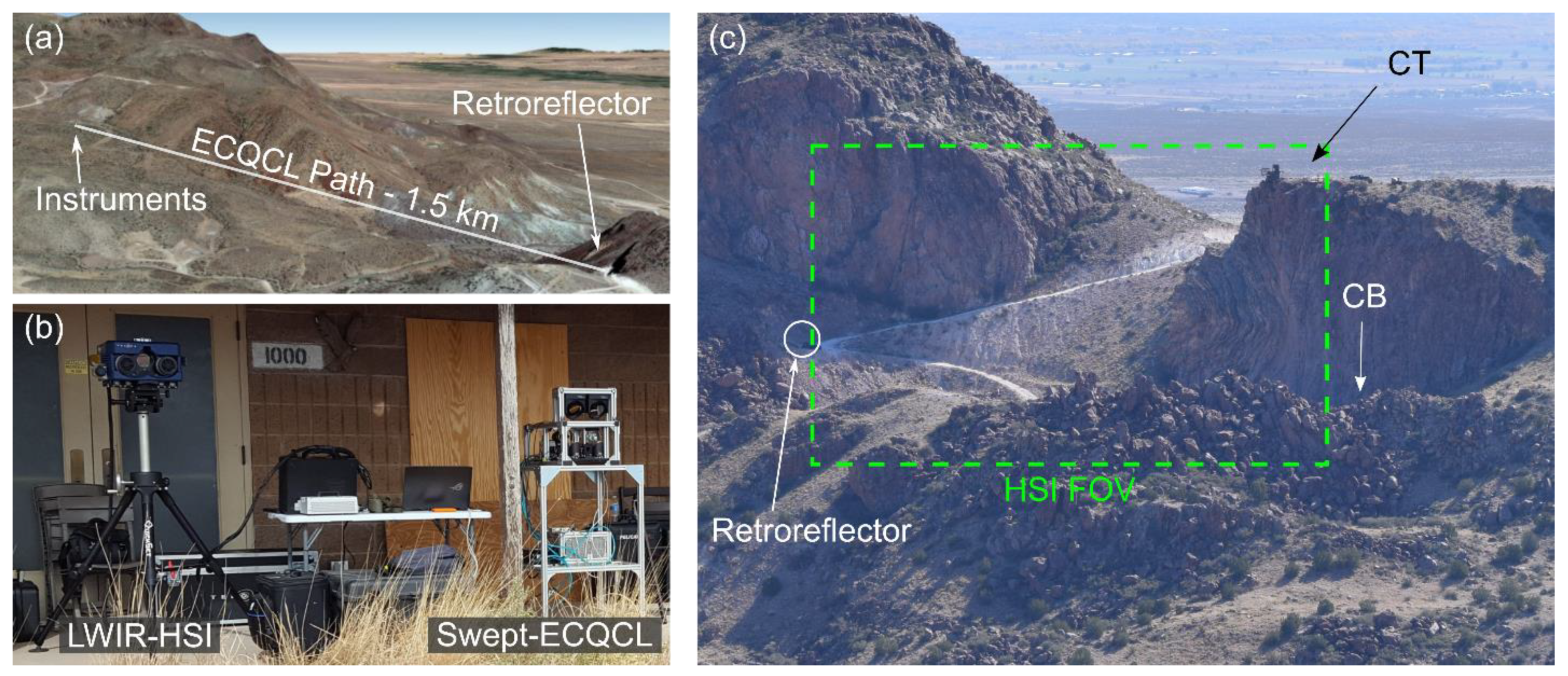
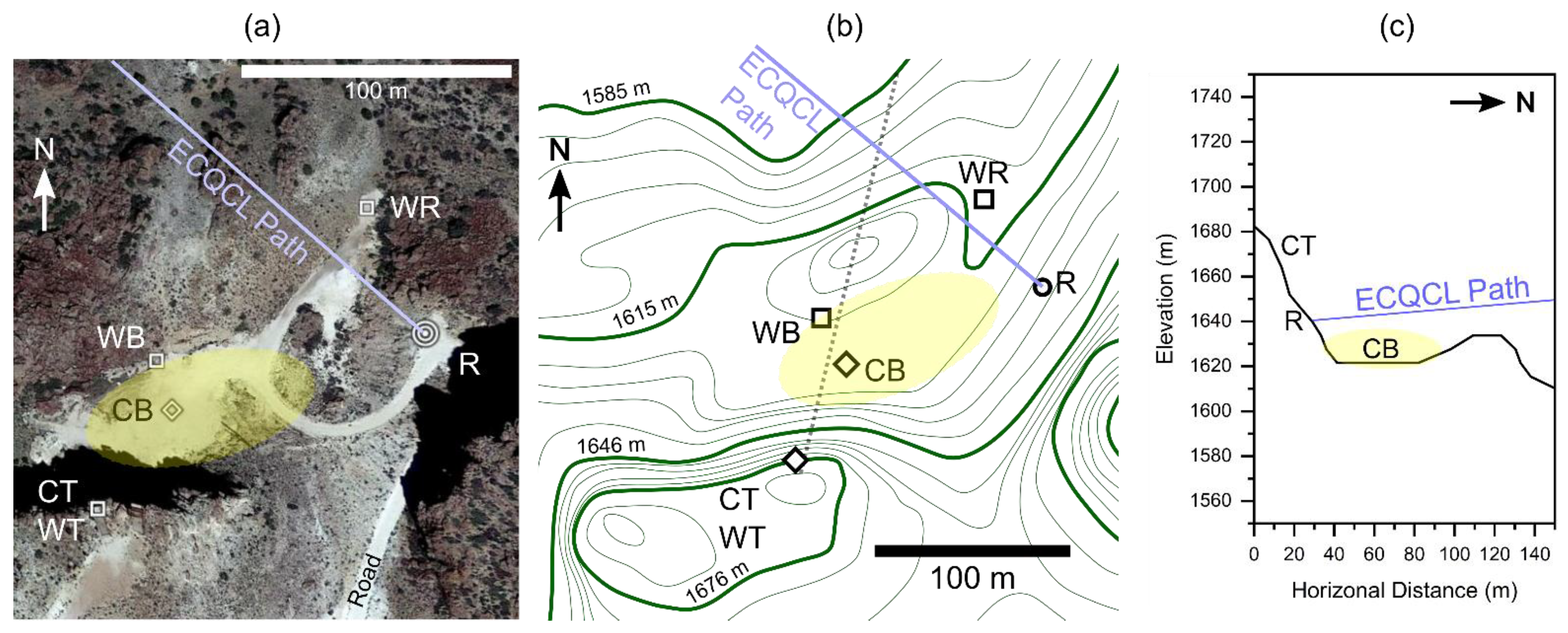
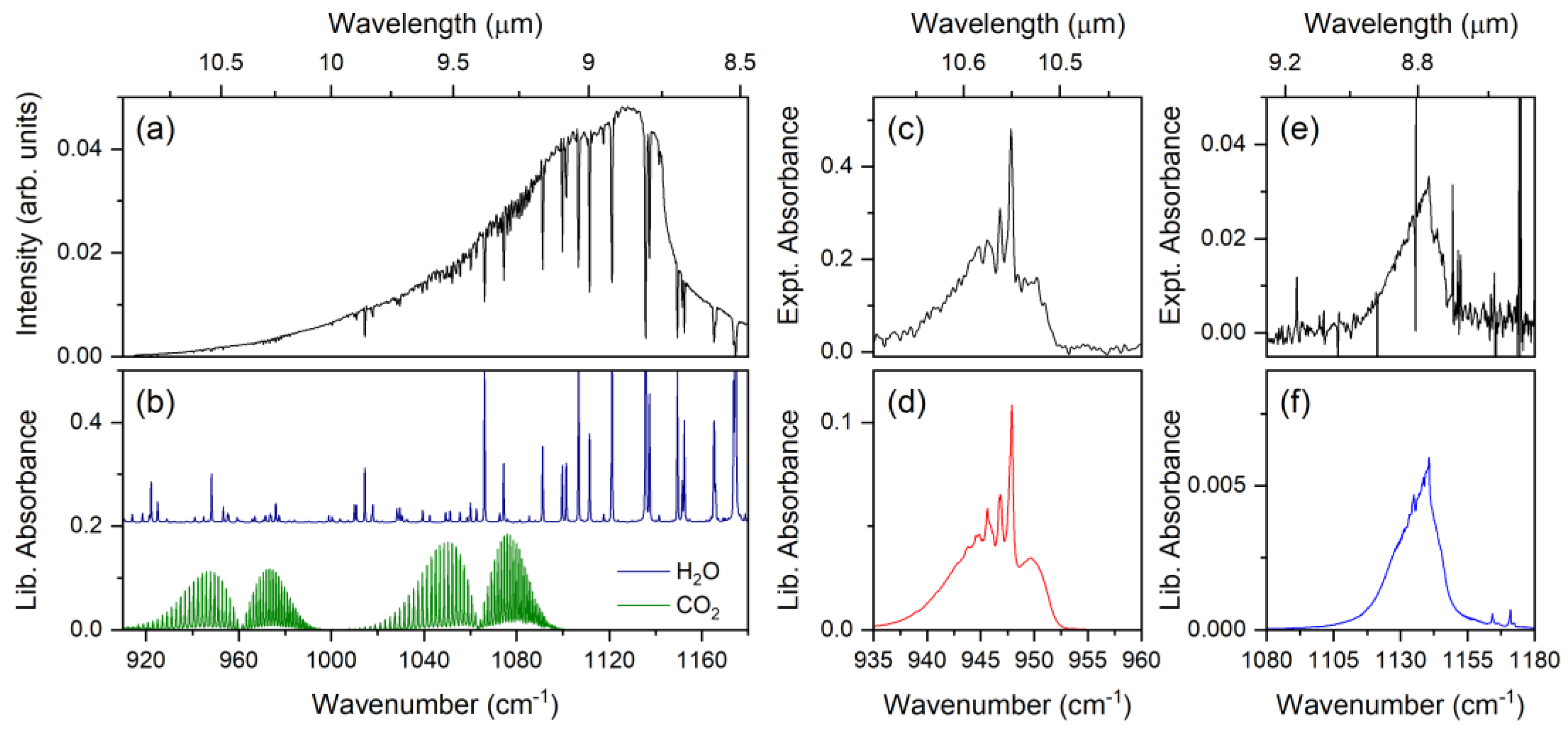
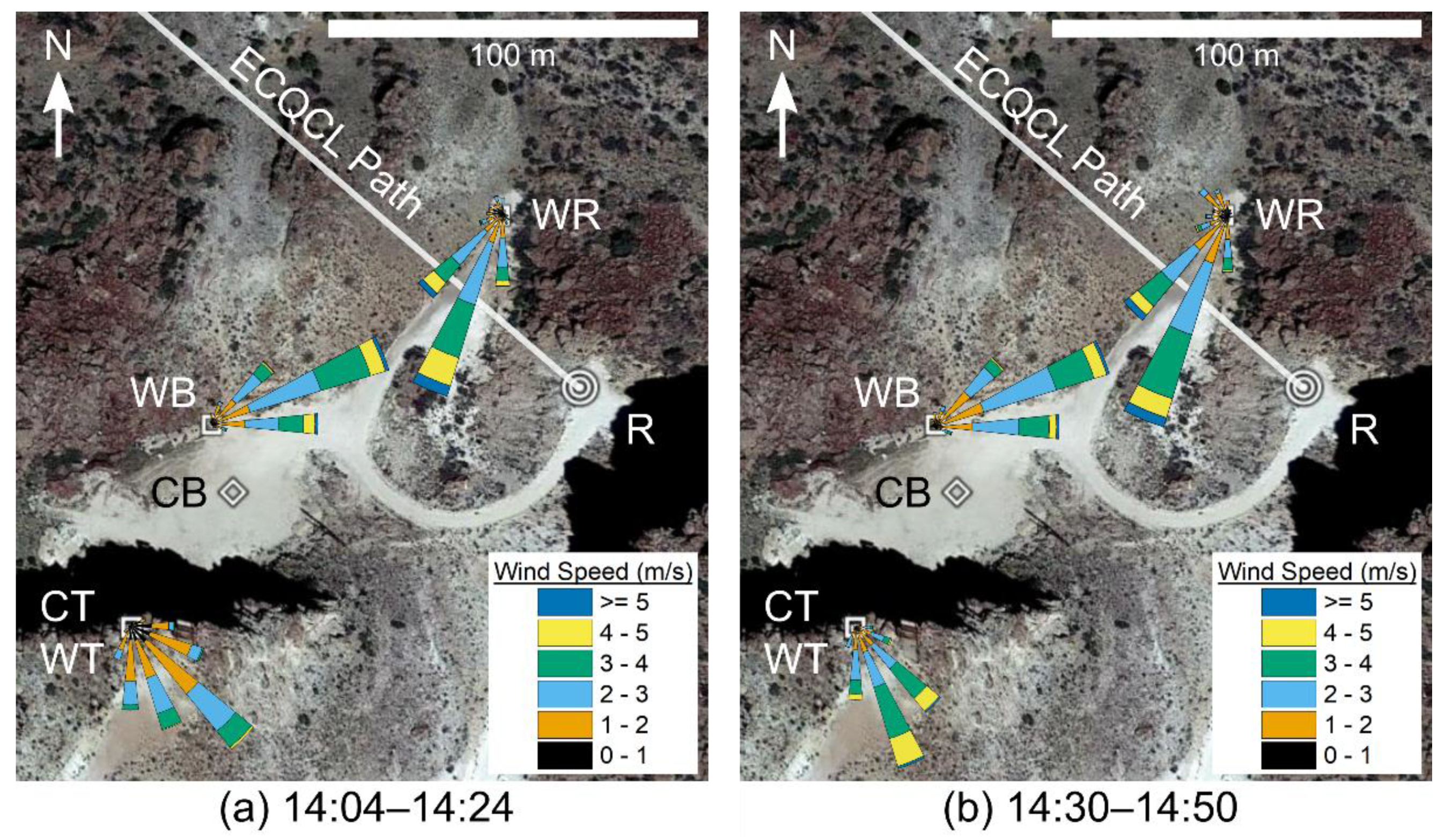
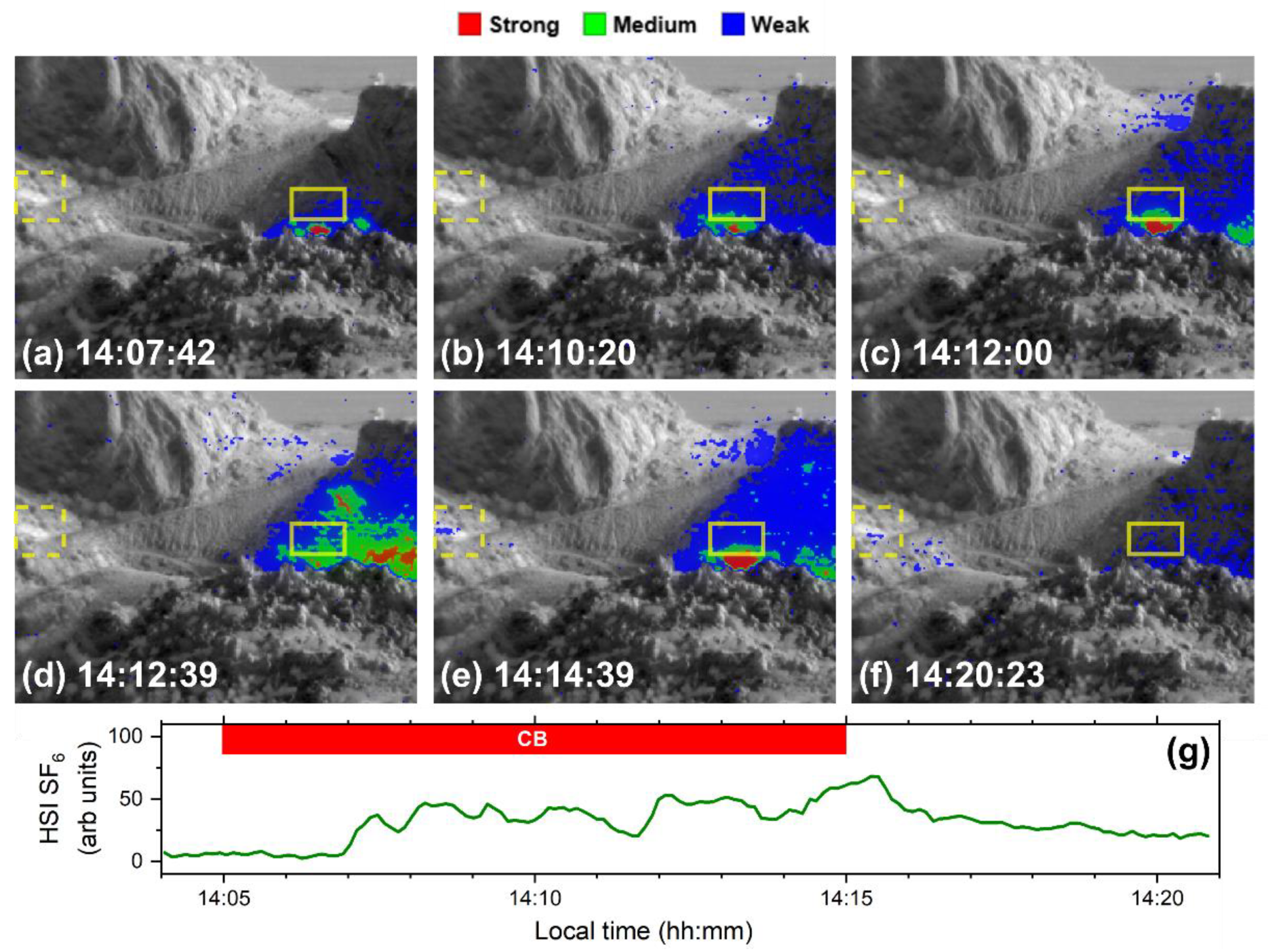

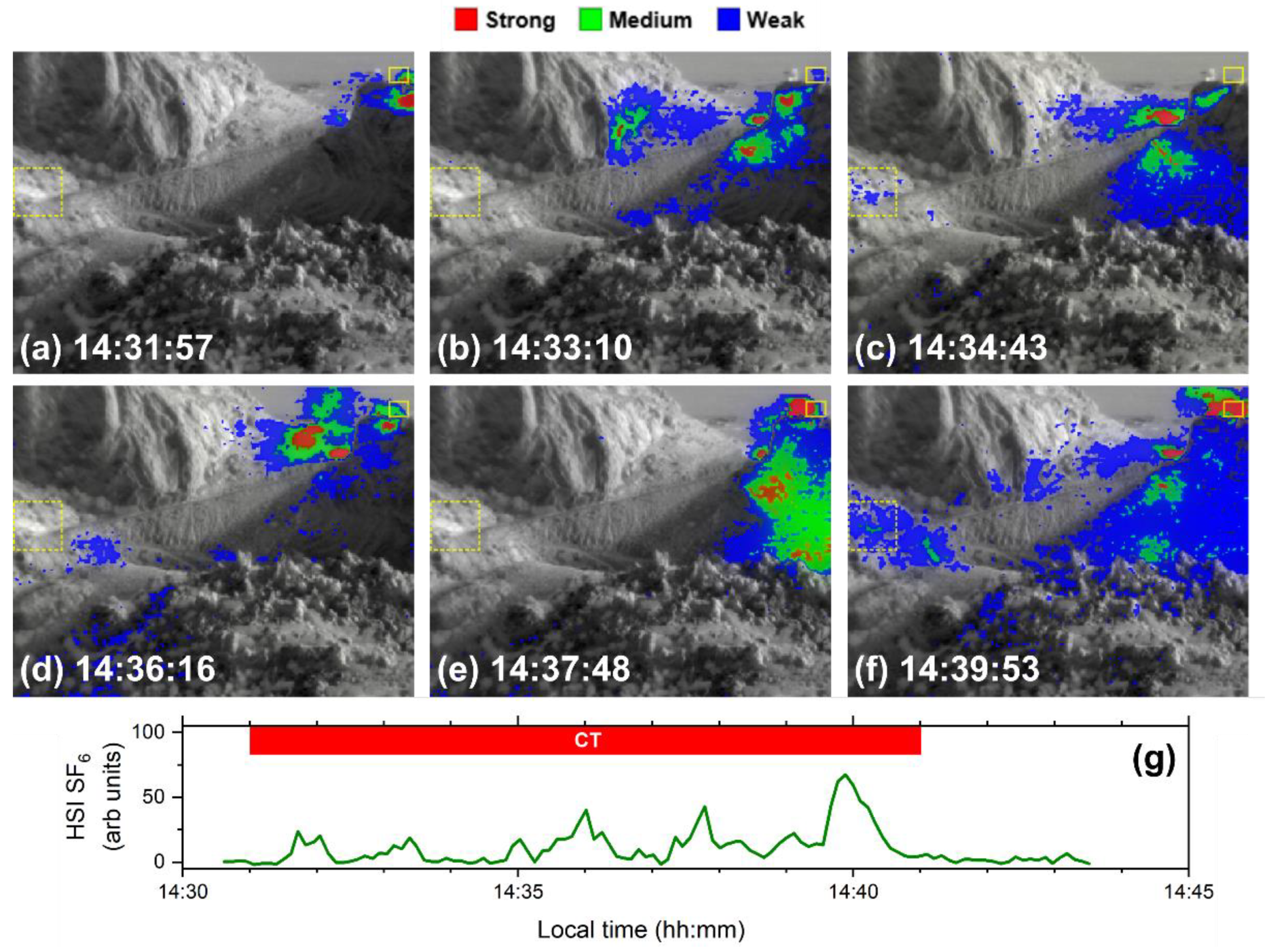
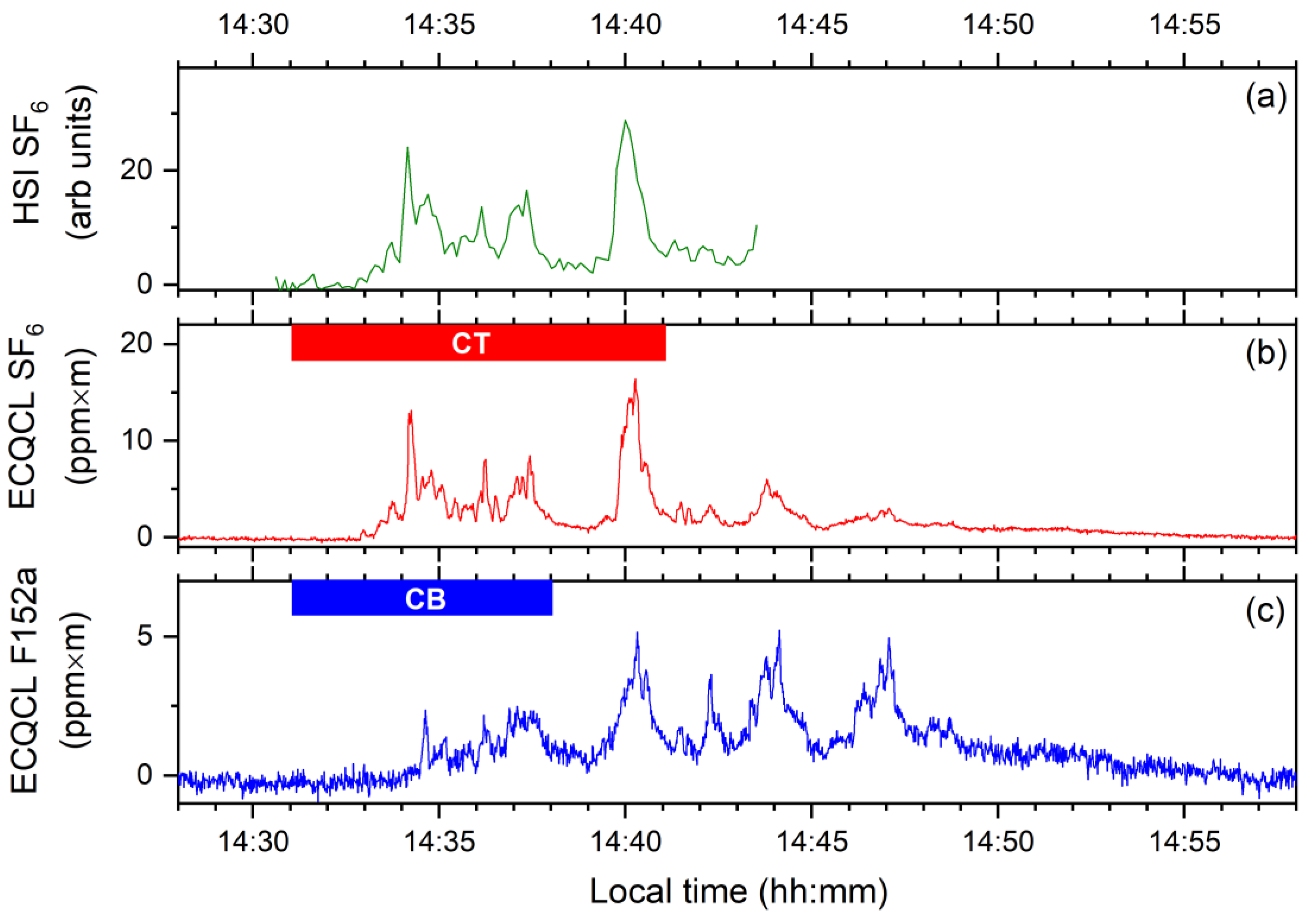
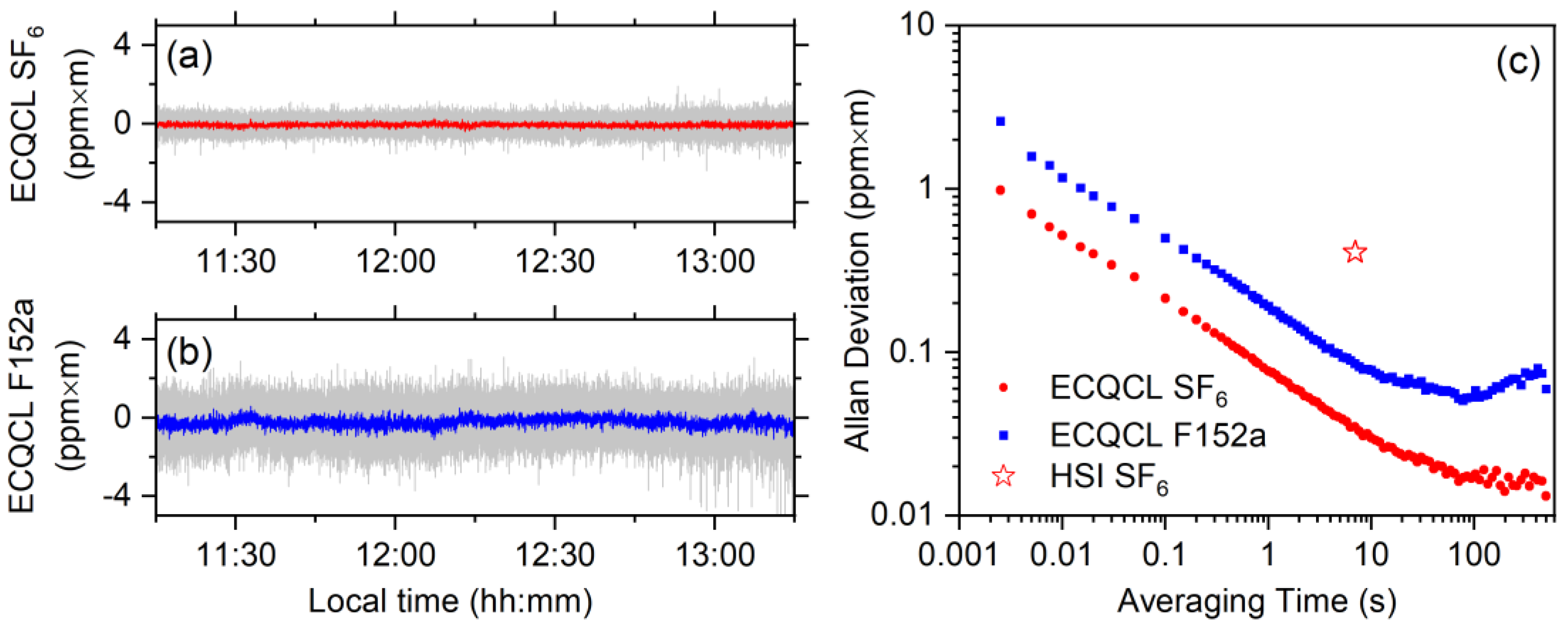
| Species | NECD | NECD | NECD | Full-Path NEC | Full-Path NEC | |
|---|---|---|---|---|---|---|
| Units | ppm × m | ppm × m | ppm × m | ppt | ppt | |
| Averaging Time | 2.5 ms | 100 ms | 1 s | 10 s | 100 s | |
| SF6 | 1.0 | 0.21 | 0.08 | 10 | 6 | |
| F152a | 2.6 | 0.50 | 0.19 | 26 | 19 |
Publisher’s Note: MDPI stays neutral with regard to jurisdictional claims in published maps and institutional affiliations. |
© 2022 by the authors. Licensee MDPI, Basel, Switzerland. This article is an open access article distributed under the terms and conditions of the Creative Commons Attribution (CC BY) license (https://creativecommons.org/licenses/by/4.0/).
Share and Cite
Phillips, M.C.; Bernacki, B.E.; Conry, P.T.; Brown, M.J. Standoff Infrared Measurements of Chemical Plume Dynamics in Complex Terrain Using a Combination of Active Swept-ECQCL Laser Spectroscopy with Passive Hyperspectral Imaging. Remote Sens. 2022, 14, 3756. https://doi.org/10.3390/rs14153756
Phillips MC, Bernacki BE, Conry PT, Brown MJ. Standoff Infrared Measurements of Chemical Plume Dynamics in Complex Terrain Using a Combination of Active Swept-ECQCL Laser Spectroscopy with Passive Hyperspectral Imaging. Remote Sensing. 2022; 14(15):3756. https://doi.org/10.3390/rs14153756
Chicago/Turabian StylePhillips, Mark C., Bruce E. Bernacki, Patrick T. Conry, and Michael J. Brown. 2022. "Standoff Infrared Measurements of Chemical Plume Dynamics in Complex Terrain Using a Combination of Active Swept-ECQCL Laser Spectroscopy with Passive Hyperspectral Imaging" Remote Sensing 14, no. 15: 3756. https://doi.org/10.3390/rs14153756







